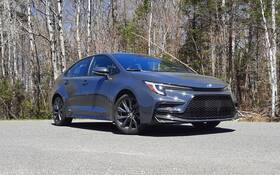2024 Toyota Corolla Hybrid: It’s No Prius But Still Worth a Look

| Strong points |
|
|---|---|
| Weak points |
|
As a leader in hybrid technology, Toyota made a great move when it electrified its compact sedan five years ago, capitalizing on the huge popularity and stellar reputation of the Corolla while realizing that the Prius would probably never go mainstream due to its design and price.
Granted, the latest Prius is seriously impressive with near-exotic looks and a much stronger powertrain than ever before, but the Corolla Hybrid still deserves consideration, as we’ve found during a recent test drive of a 2024 model in SE AWD trim.
- Also: 2024 Toyota Corolla Cross: The Ace Up Toyota's Sleeve
- Also: 2024 Toyota Corolla Tries Its Best to Fight Inflation
Four Hybrid Models
Buying a Toyota Corolla Hybrid is mainly about reliability, safety and of course fuel economy, particularly in city driving. On that note, the most efficient model is the base LE FWD with a combined NRC rating of 4.7 L/100 km. It’ll cost you $29,571 including all the various charges and comes fairly well equipped except for the missing leather-wrapped and heated steering wheel.

You can get one along with all-wheel drive (with a small electric motor driving the rear axle) if you spend an extra $1,500 to move up to the LE AWD. This one is rated at 4.9 L/100 km, while the additional torque and drive wheels make for safer, more pleasant operation regardless of weather conditions. However, while the small 15-inch wheels and narrow tires reduce rolling resistance and therefore maximize fuel economy (and make for a quieter ride), they compromise handling and stability in corners.
It’s the opposite with the Corolla Hybrid SE AWD ($33,231), which rides on 18-inch wheels and wider rubber but consequently burns more gas. Officially, it achieves 5.3 L/100 km. Our tester somehow still had its winter boots on and we had to face unseasonably cold temperatures during the week, resulting in a real-world average of 5.8 L/100 km. Keep in mind that we used Eco mode the vast majority of the time and seldom tried to push the 1.8-litre four-cylinder, which proves noisy under hard acceleration.

The other drive modes—Normal and Sport—are easy to activate thanks to a little toggle switch on the centre console that doesn’t require you to take your eyes off the road. But honestly, the difference is pretty negligible, and since the primary purpose of the Corolla Hybrid is to go from A to B in the smoothest and most efficient way possible, Eco mode has to be the default choice.
In case you haven’t noticed, black-finished wheels, rear lip spoiler and diffuser-style bumper garnish combined with dual tailpipes give the SE AWD a sportier appearance. Same thing with the top-line XSE AWD at $37,631, which is loaded with features including a wireless smartphone charger, sunroof, Drive Connect with virtual assistant and cloud-based navigation (you don’t really need that with wireless Android Auto and Apple CarPlay integration) as well as leatherette seats with 8-way power adjustment for the driver. Incidentally, the seats in the three other Corolla Hybrid models are appointed in fabric and manually adjustable only, but we still found them quite comfortable and supportive (as least the front buckets).

Now, there are two more things you need to know. First, the ride is firm but not unpleasant thanks to the multi-link rear suspension, and steering is responsive enough. Other compact sedans are more agile and more fun to drive, obviously, but don’t underestimate this Toyota. Seriously.
Second, there’s a way to increase energy recuperation through regenerative braking (with the shifter in “B”), but this makes the engine annoyingly loud and doesn’t automatically put the car back in EV mode at low speeds or at idle (you need to press the “EV” button on the console every time). It’s best to use this function on highways and byroads, and leave the shifter in “D” when driving around town and in traffic so as to maximize EV operation.
Hybrid or Gasoline?
The Toyota Corolla Hybrid’s modest 138 horsepower support its green-car status. Most customers will simply want to save as much gas and money as possible, hence the appeal of the entry-level LE models. Those who care about dynamic handling or generous content should probably consider another vehicle.

Compared with a gas-powered, 169-horsepower Corolla (LE model starting at an all-inclusive price of $27,271), the difference in fuel consumption is 2 L/100 km in the best-case scenario. Assuming gas prices would stay at $1.80 per litre for the next few years, buying a Corolla Hybrid would theoretically be a worthwhile investment after 73,500 km. If you don’t plan to get there, then forget it. Of course, depending on where you live in Canada, gas could be cheaper than that, so you’d get a ROI sooner.
Likewise, if most of your driving takes place on the highway, a standard Corolla or another efficient compact car such as the Volkswagen Jetta or Nissan Sentra will probably give you better value. By the way, it’s a shame the Corolla Hybrid comes in four-door configuration only and not as a hatchback, too. Remember, Honda is about to launch the 2025 Civic Hybrid in both body styles—possibly at a higher price and with lower fuel economy, mind you.











